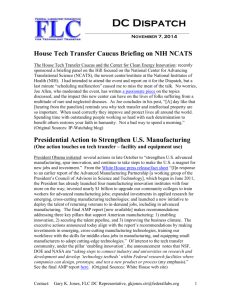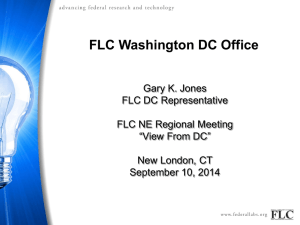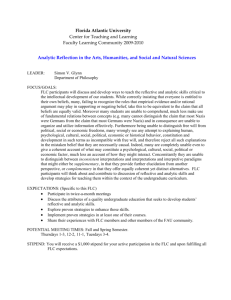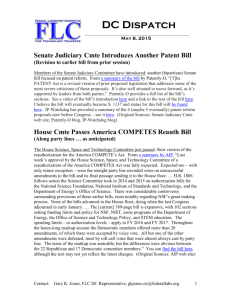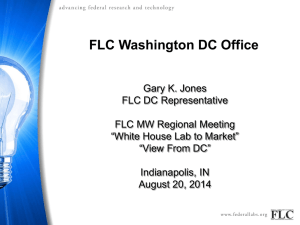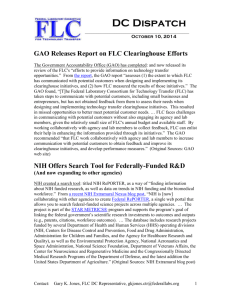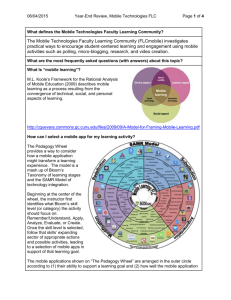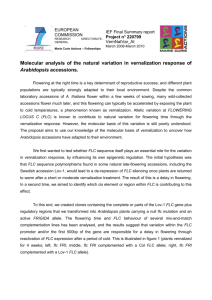August 21 - Federal Laboratory Consortium for Technology Transfer
advertisement
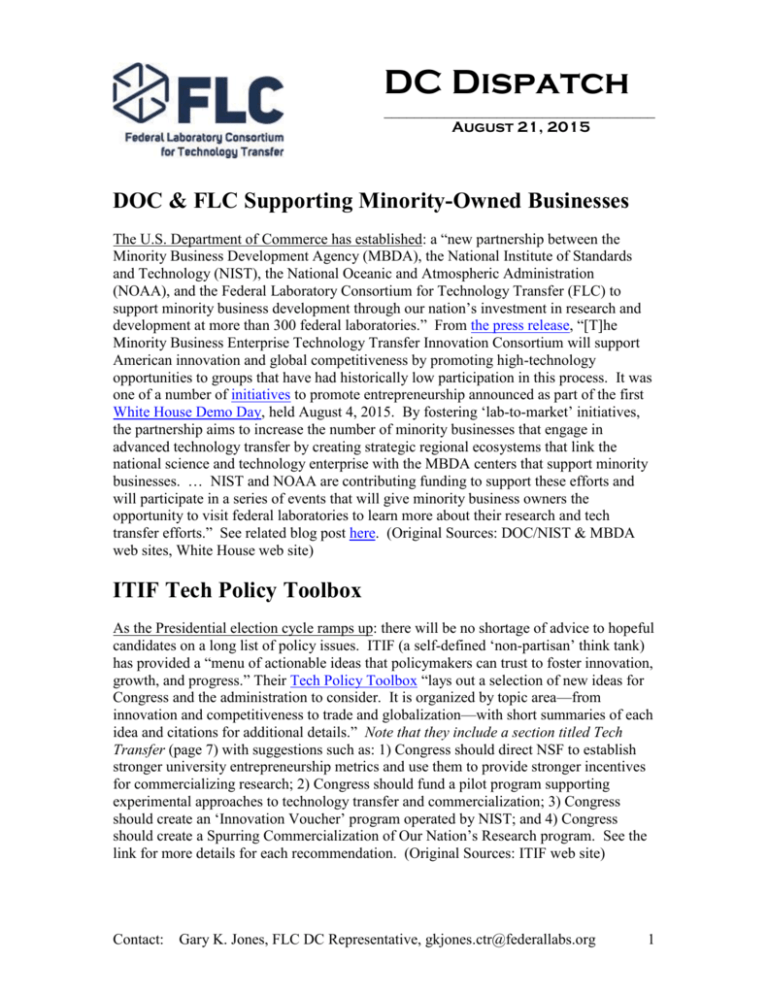
DC Dispatch ____________________________________ August 21, 2015 DOC & FLC Supporting Minority-Owned Businesses The U.S. Department of Commerce has established: a “new partnership between the Minority Business Development Agency (MBDA), the National Institute of Standards and Technology (NIST), the National Oceanic and Atmospheric Administration (NOAA), and the Federal Laboratory Consortium for Technology Transfer (FLC) to support minority business development through our nation’s investment in research and development at more than 300 federal laboratories.” From the press release, “[T]he Minority Business Enterprise Technology Transfer Innovation Consortium will support American innovation and global competitiveness by promoting high-technology opportunities to groups that have had historically low participation in this process. It was one of a number of initiatives to promote entrepreneurship announced as part of the first White House Demo Day, held August 4, 2015. By fostering ‘lab-to-market’ initiatives, the partnership aims to increase the number of minority businesses that engage in advanced technology transfer by creating strategic regional ecosystems that link the national science and technology enterprise with the MBDA centers that support minority businesses. … NIST and NOAA are contributing funding to support these efforts and will participate in a series of events that will give minority business owners the opportunity to visit federal laboratories to learn more about their research and tech transfer efforts.” See related blog post here. (Original Sources: DOC/NIST & MBDA web sites, White House web site) ITIF Tech Policy Toolbox As the Presidential election cycle ramps up: there will be no shortage of advice to hopeful candidates on a long list of policy issues. ITIF (a self-defined ‘non-partisan’ think tank) has provided a “menu of actionable ideas that policymakers can trust to foster innovation, growth, and progress.” Their Tech Policy Toolbox “lays out a selection of new ideas for Congress and the administration to consider. It is organized by topic area—from innovation and competitiveness to trade and globalization—with short summaries of each idea and citations for additional details.” Note that they include a section titled Tech Transfer (page 7) with suggestions such as: 1) Congress should direct NSF to establish stronger university entrepreneurship metrics and use them to provide stronger incentives for commercializing research; 2) Congress should fund a pilot program supporting experimental approaches to technology transfer and commercialization; 3) Congress should create an ‘Innovation Voucher’ program operated by NIST; and 4) Congress should create a Spurring Commercialization of Our Nation’s Research program. See the link for more details for each recommendation. (Original Sources: ITIF web site) Contact: Gary K. Jones, FLC DC Representative, gkjones.ctr@federallabs.org 1 New ‘IP Bank’ Launched Earlier this summer the Dominion Harbor Group launched: an ‘IP Bank’ with “the purpose of working to seed promising young companies with high-quality, curated IP that buttresses their products and services, strengthens their market position, expedites venture funding, and increases the likelihood of an IPO or other strategic market success.” From an IP-Watchdog post on the subject, “[M]any large corporations are sitting on stockpiles of patents, which are not core to the corporations business but nevertheless represent an asset that could be useful if placed in the right hands. There are also startup companies that find themselves in need of patent rights to take next steps in business development, such as for the purpose of raising capital from investors. Into this fray enters a new institution called the Monument Bank of Intellectual Property. Rather than a startup going to the IP Bank for a loan, they can go to the IP Bank to acquire patents that can be used to build a portfolio or to supplement their already growing organic patent portfolio. The IP Bank is looking to strengthen startups and, in the process, enhance innovation and job creation. … Already the IP Bank has … given more [than] a dozen startups access to more than 1,000 patent assets from roughly 20 bank depositors. By year-end, it expects to have between 5,000-10,000 patents from 50 major depositors. Patents in the bank cover a range of technology areas, including energy, health care, finance, automotive, materials, green chemistry, and general technology.” (Original Sources: IP-Watchdog blog, Monument IP Bank web site) Fun Facts: Patent Grant Rates by Tech Area The blog Patently-O has prepared: a chart showing patent grant rates – by technology area – from 2005 to present. From the post “there are several overall trends that are easy to discern. In particular, the general trend reported last week – a drop in grant rate followed by a rise once Director Kappos took charge – is present in each of the major technology areas. In general, you will also see less variance between the technology areas in later years. It is unclear at this point if that coming-together is due more to USPTO practices or to applicant practices or some other unknown factor. The major outlier in the group is electronic commerce patent applications. Those applications continue to be granted at a rate of < 10%.” (Original Sources: Patently-O blog) ---------------------------------------------------------------------------------------------- Note: The DC Dispatch is a periodic update of selected items of interest to the FLC and technology transfer community -- i.e., current legislation, trends, reports, policy and other developments potentially affecting technology transfer or related activities -- designed to keep the community informed of relevant issues on a timely basis. Information is gleaned directly from a variety of sources (newsletters, email alerts, web sites, direct participation at events from the FLC DC Representative’s office, etc.) -- with original sources, contacts and links provided. Contact: Gary K. Jones, FLC DC Representative, gkjones.ctr@federallabs.org 2
